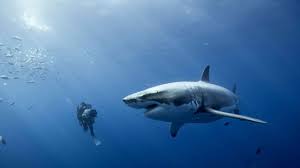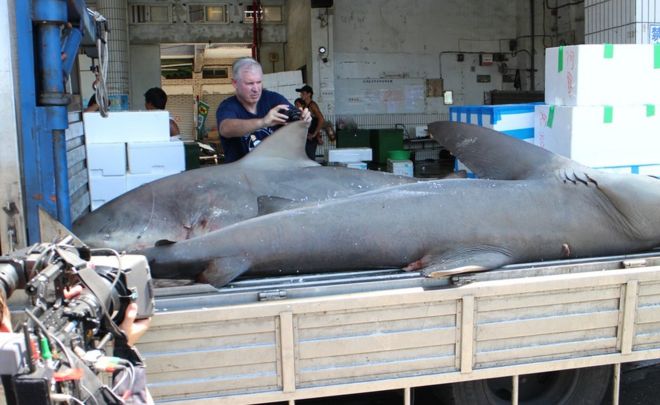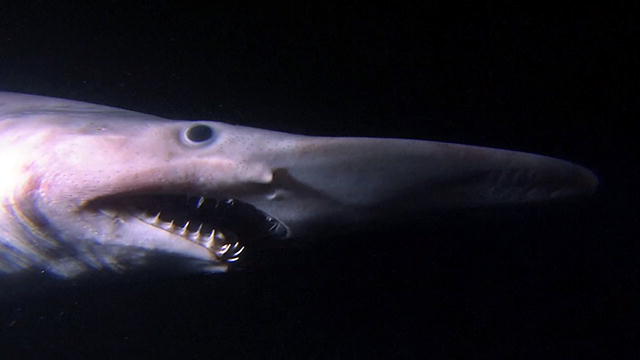Sea Save Foundation
Contributor
Shark Bytes!
 The Neuroecology Group at the University of Western Australia tested the effectiveness of different deterrents that has worked on other aquatic vertebrates or currently available commercial shark deterrents. They tested methods such as strobe lights, sounds, and bubble barriers. The article highlights the major findings from the research, and it will be published later this year. The scientists hope that this can be used to develop new shark deterrent technologies in the future. Read more...
The Neuroecology Group at the University of Western Australia tested the effectiveness of different deterrents that has worked on other aquatic vertebrates or currently available commercial shark deterrents. They tested methods such as strobe lights, sounds, and bubble barriers. The article highlights the major findings from the research, and it will be published later this year. The scientists hope that this can be used to develop new shark deterrent technologies in the future. Read more...
-----------------------------------------------
 Scientists have believed for many years that sharks had negative buoyancy, or sank when they were not swimming. However, from a recent study scientists conducted by University of Hawai'i Maui's Hawaii Institute of Marine Biology have found that there are at least two species have sharks who have positive buoyancy, or who float, like other fish. They attached monitors onto sharks fins that track their acceleration and found that the sharks accelerated more, or had more difficulty swimming down than up. The team believes this evolution in buoyancy could be so the sharks do not have to use their cold muscles to rise. Read more...
Scientists have believed for many years that sharks had negative buoyancy, or sank when they were not swimming. However, from a recent study scientists conducted by University of Hawai'i Maui's Hawaii Institute of Marine Biology have found that there are at least two species have sharks who have positive buoyancy, or who float, like other fish. They attached monitors onto sharks fins that track their acceleration and found that the sharks accelerated more, or had more difficulty swimming down than up. The team believes this evolution in buoyancy could be so the sharks do not have to use their cold muscles to rise. Read more...
3. Sharks, Humans Living so Close; Why Not More Attacks?
 It seems obvious when I say theres an increase in human population. There are more people who engage in recreational water sports where they enter shark territory, yet the shark attacks are not increasing. With basic math, shark biology, improved shark detection methods, and other factors, it keeps the shark attack numbers low. Although the news likes to spice things up with headlines like Attack in Hawaii Triples compared to eight years ago, when you look at the actual numbers, the attacks are in the single digits. So do not threat; there are less sharks in the waters (slow-reproduction, overfishing) and factoring in how uncommon attacks are, no one need to be paranoid about a Jaws situation. Read more...
It seems obvious when I say theres an increase in human population. There are more people who engage in recreational water sports where they enter shark territory, yet the shark attacks are not increasing. With basic math, shark biology, improved shark detection methods, and other factors, it keeps the shark attack numbers low. Although the news likes to spice things up with headlines like Attack in Hawaii Triples compared to eight years ago, when you look at the actual numbers, the attacks are in the single digits. So do not threat; there are less sharks in the waters (slow-reproduction, overfishing) and factoring in how uncommon attacks are, no one need to be paranoid about a Jaws situation. Read more...
The worlds second biggest fish, the Basking Shark, was caught off the coast of Australia. This species has not been seen in 80 years and only three were reported in the last 160 years. Because the Basking Shark is so rare not much is known about them. The carcass has been taken to Museum Victoria for research purposes. Read more...
When it comes to music and sharks, nothing jumps out like the theme song from Jaws - dun-dun, dun-dun, dun-dun . Andy Brandy Casagrande IV (aka "ABC4"), one of Discovery's Shark Week stars, gives us a different version and ventures beyond the cage to serenade his favorite shark. Read more...
 The Seal Beach Marine Safety Department may have found an unexpected use for their new $1,400 drone. Initially purchased to document the department's Jr. Lifeguard Program, officials have found other uses, such as spotting sharks and strong currents. Could drones be a cost-effective way to help protect both sharks and swimmers? While drones often spark debates over privacy and other issues, this could be an interesting alternative to shark culling programs and prove invaluable to shark identification and research. Read more...
The Seal Beach Marine Safety Department may have found an unexpected use for their new $1,400 drone. Initially purchased to document the department's Jr. Lifeguard Program, officials have found other uses, such as spotting sharks and strong currents. Could drones be a cost-effective way to help protect both sharks and swimmers? While drones often spark debates over privacy and other issues, this could be an interesting alternative to shark culling programs and prove invaluable to shark identification and research. Read more...
-----------------------------------------------
If you think you've seen some interesting creatures in foreign markets, meet Dave Ebert. Over the past three decades, he's named 24 new species of sharks, rays, sawfish, and ghost sharks with 10 of those coming from one market in Taiwan alone. Ebert also estimates that he has 30 or more species in his California collection, which are awaiting formal identification. The article reports that of the 500 known species of sharks a fifth of those have been found in the decade alone. Let's hope that trend continues.
Read more...
-----------------------------------------------
We live by lists. Top 10 this, best 20 that. Why should sharks be any different? Check out this ranking of the best sharks on our planet, ranked by most unusual. Who will come out on top? The goblin shark, great white, or wobbegong? Read more...
Be sure to "LIKE" http://facebook.com/SeaSave to ensure our "Week in Review" is delivered to your newsfeed every Thursday.
Sea Save Foundation is committed to raising awareness of marine conservation. The Week in Review is a team effort produced by the Sea Save staff to provide a weekly summary of the latest in marine research, policy, and news.
Less than one week left until Discovery's Shark Week! Can't control your excitement? Need to find a way to pass the time? Take a look at some fascinating recent stories that our Sea Save team has collected!
1. Shark Deterrent Research Shows Interesting Results
1. Shark Deterrent Research Shows Interesting Results
-----------------------------------------------
2. Deep Sea Sharks Showing Buoyancy
 Scientists have believed for many years that sharks had negative buoyancy, or sank when they were not swimming. However, from a recent study scientists conducted by University of Hawai'i Maui's Hawaii Institute of Marine Biology have found that there are at least two species have sharks who have positive buoyancy, or who float, like other fish. They attached monitors onto sharks fins that track their acceleration and found that the sharks accelerated more, or had more difficulty swimming down than up. The team believes this evolution in buoyancy could be so the sharks do not have to use their cold muscles to rise. Read more...
Scientists have believed for many years that sharks had negative buoyancy, or sank when they were not swimming. However, from a recent study scientists conducted by University of Hawai'i Maui's Hawaii Institute of Marine Biology have found that there are at least two species have sharks who have positive buoyancy, or who float, like other fish. They attached monitors onto sharks fins that track their acceleration and found that the sharks accelerated more, or had more difficulty swimming down than up. The team believes this evolution in buoyancy could be so the sharks do not have to use their cold muscles to rise. Read more...-----------------------------------------------
3. Sharks, Humans Living so Close; Why Not More Attacks?
 It seems obvious when I say theres an increase in human population. There are more people who engage in recreational water sports where they enter shark territory, yet the shark attacks are not increasing. With basic math, shark biology, improved shark detection methods, and other factors, it keeps the shark attack numbers low. Although the news likes to spice things up with headlines like Attack in Hawaii Triples compared to eight years ago, when you look at the actual numbers, the attacks are in the single digits. So do not threat; there are less sharks in the waters (slow-reproduction, overfishing) and factoring in how uncommon attacks are, no one need to be paranoid about a Jaws situation. Read more...
It seems obvious when I say theres an increase in human population. There are more people who engage in recreational water sports where they enter shark territory, yet the shark attacks are not increasing. With basic math, shark biology, improved shark detection methods, and other factors, it keeps the shark attack numbers low. Although the news likes to spice things up with headlines like Attack in Hawaii Triples compared to eight years ago, when you look at the actual numbers, the attacks are in the single digits. So do not threat; there are less sharks in the waters (slow-reproduction, overfishing) and factoring in how uncommon attacks are, no one need to be paranoid about a Jaws situation. Read more...-----------------------------------------------
4. Rare, Huge Basking Shark Caught Off Australia
The worlds second biggest fish, the Basking Shark, was caught off the coast of Australia. This species has not been seen in 80 years and only three were reported in the last 160 years. Because the Basking Shark is so rare not much is known about them. The carcass has been taken to Museum Victoria for research purposes. Read more...
-----------------------------------------------
5. The Great White Shark Song by ABC4
When it comes to music and sharks, nothing jumps out like the theme song from Jaws - dun-dun, dun-dun, dun-dun . Andy Brandy Casagrande IV (aka "ABC4"), one of Discovery's Shark Week stars, gives us a different version and ventures beyond the cage to serenade his favorite shark. Read more...
-----------------------------------------------
6. Could Drones Help Reduce Shark Attacks?
-----------------------------------------------
7. Meet the Man Whos Named 24 Shark Species
If you think you've seen some interesting creatures in foreign markets, meet Dave Ebert. Over the past three decades, he's named 24 new species of sharks, rays, sawfish, and ghost sharks with 10 of those coming from one market in Taiwan alone. Ebert also estimates that he has 30 or more species in his California collection, which are awaiting formal identification. The article reports that of the 500 known species of sharks a fifth of those have been found in the decade alone. Let's hope that trend continues.
Read more...
-----------------------------------------------
8. Ranking of the Best, Most Unusual Sharks
We live by lists. Top 10 this, best 20 that. Why should sharks be any different? Check out this ranking of the best sharks on our planet, ranked by most unusual. Who will come out on top? The goblin shark, great white, or wobbegong? Read more...
-----------------------------------------------
Be sure to "LIKE" http://facebook.com/SeaSave to ensure our "Week in Review" is delivered to your newsfeed every Thursday.
Sea Save Foundation is committed to raising awareness of marine conservation. The Week in Review is a team effort produced by the Sea Save staff to provide a weekly summary of the latest in marine research, policy, and news.








